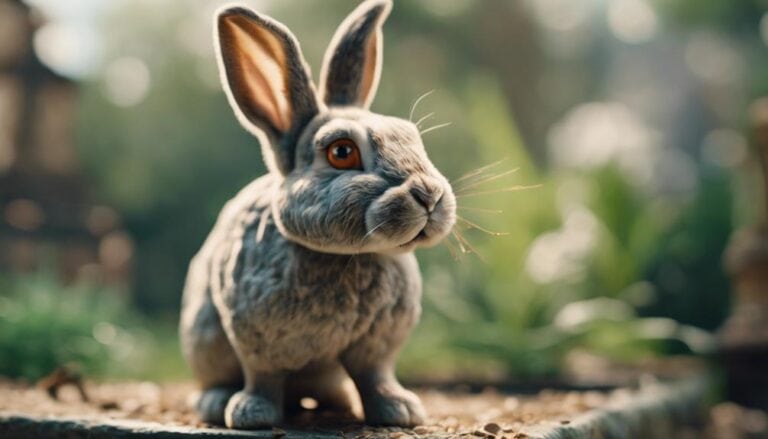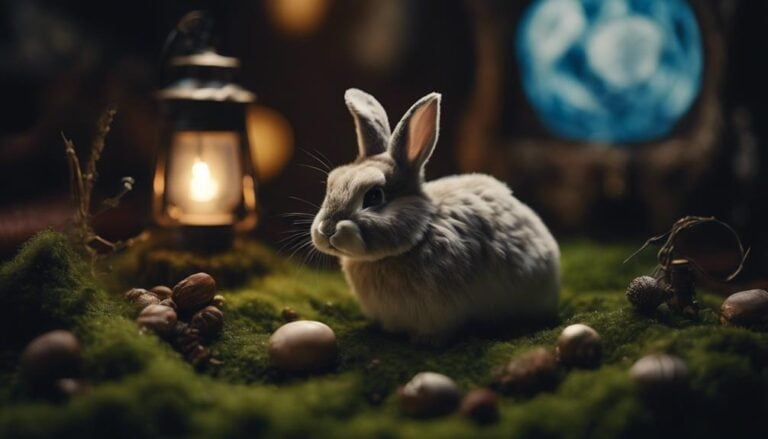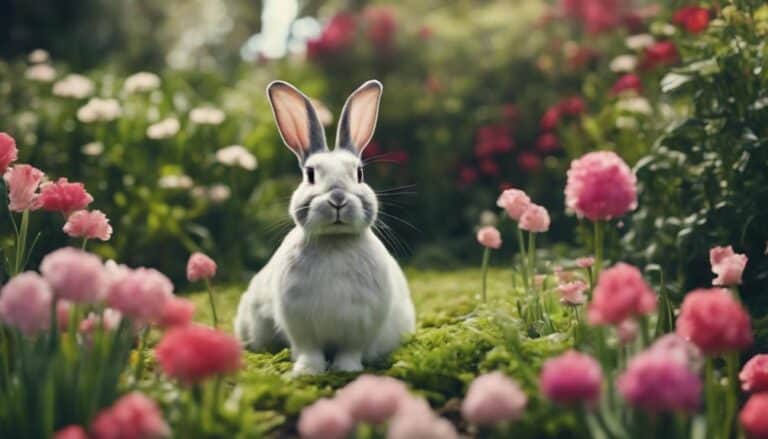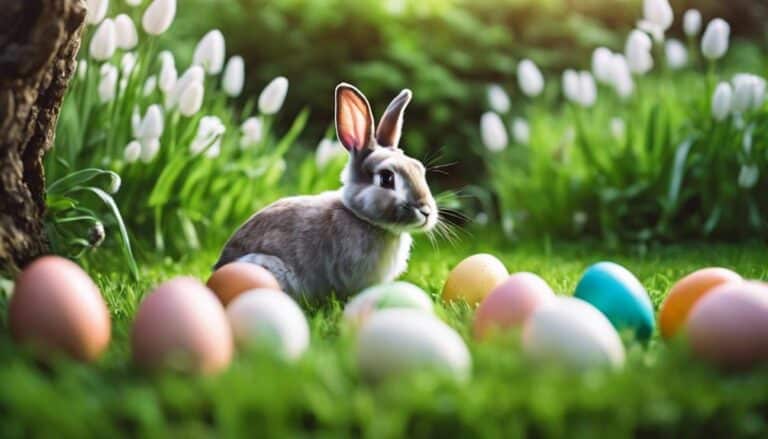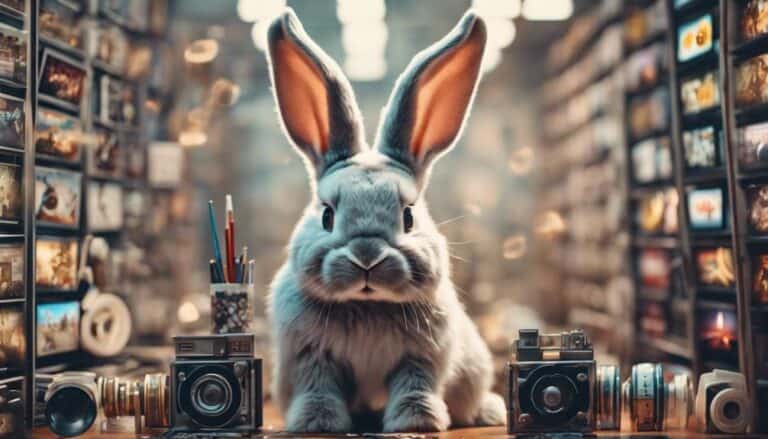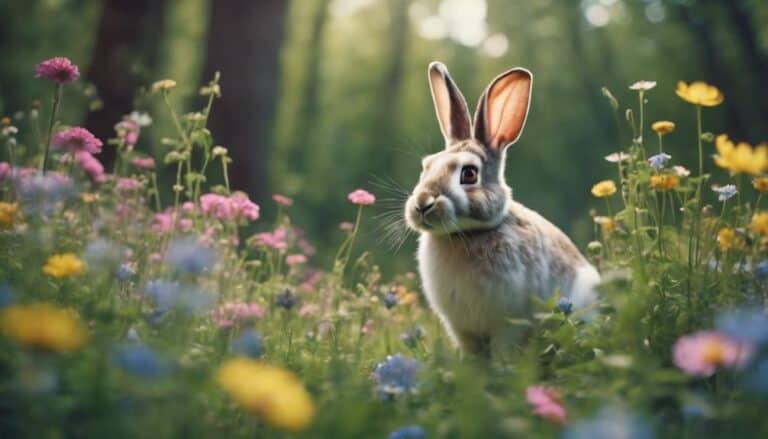Have you ever wondered about the profound symbolism and cultural significance attached to bunnies?
From ancient civilizations to modern literature, these furry creatures have woven themselves into the tapestry of our collective consciousness.
As you explore the intricate web of bunny symbolism in various art forms and cultures, you will uncover a rich tapestry of meanings that go beyond their fluffy exterior.
Contents
- 1 Key Takeaways
- 2 Bunny Symbolism in Literature
- 3 Bunny Symbolism in Poetry
- 4 Cultural Impact of Bunny Symbolism
- 5 Bunny Symbolism in Global Literature
- 6 Bunny Symbolism in Diverse Cultures
- 7 Evolution of Bunny Symbolism in Writing
- 8 Bunny Symbolism in Classic Works
- 9 Modern Interpretations of Bunny Symbolism
- 10 Frequently Asked Questions
- 11 Conclusion
Key Takeaways
- Bunnies symbolize fertility, rebirth, and innocence in global literature and art.
- Cultural narratives and folklore globally depict bunnies as symbols of cleverness and resilience.
- Bunnies hold significant cultural symbolism, embodying traits of strength, joy, and interconnectedness.
- Mythology and folklore attribute various symbolic meanings to bunnies, from tricksters to fertility symbols.
Bunny Symbolism in Literature
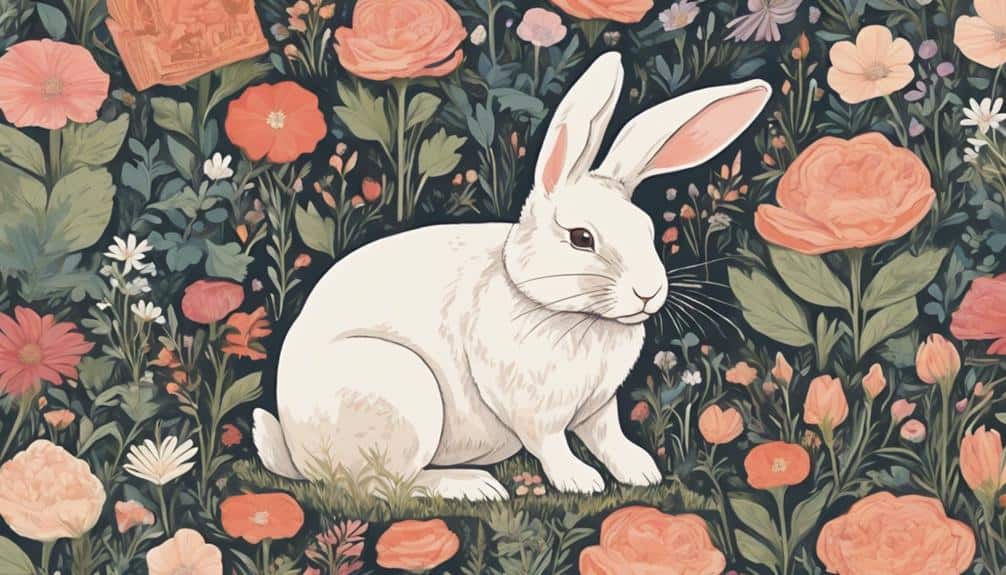
In literary works, bunnies serve as compelling symbols, embodying traits of curiosity, intelligence, and adventure, enriching the narratives they inhabit. Through various characters like Bugs Bunny and Peter Rabbit, bunnies in literature are portrayed as mischievous, clever, and resourceful beings. These rabbit characters not only entertain audiences but also convey deeper meanings through their actions and personalities. Bunnies often symbolize qualities such as sensitivity, playfulness, and exploration, reflecting their cultural importance as more than just fluffy creatures.
In stories like 'Alice's Adventures in Wonderland' and 'Watership Down,' rabbit symbolism is prevalent, showcasing bunnies as representations of joy, kindness, and curiosity. These symbolic meanings add layers to the narratives they're a part of, inviting readers to ponder on themes beyond the surface level. Moreover, in media, rabbit characters can embody leadership qualities, strong bonds, bravery, and mischief, further solidifying the diverse symbolic significance of bunnies in literature.
Bunny Symbolism in Poetry
Symbolizing innocence, purity, and playfulness, bunnies in poetry captivate readers with their evocative representations of fertility, rebirth, and new beginnings. Poets often weave these gentle creatures into their verses to evoke a sense of hope and renewal.
The bunny's symbolism of fertility mirrors the bountiful potential of new beginnings, while its association with rebirth and resurrection adds layers of depth to poetic works. Through the lens of innocence and purity, bunnies in poetry become catalysts for exploring themes of growth and transformation.
Their playful nature infuses verses with a sense of joy and light-heartedness, offering readers a moment of respite from the complexities of life. Overall, bunny symbolism in poetry serves as a reminder of the cyclical nature of existence, where endings give birth to new opportunities and where the promise of tomorrow is wrapped in the soft fur of these beloved creatures.
Cultural Impact of Bunny Symbolism

With a rich history spanning ancient civilizations like the Egyptians and Romans, bunny symbolism has left an indelible mark on cultures worldwide, embodying themes of fertility, prosperity, and cultural significance.
Rabbits, as symbols of fertility, have been revered in various societies for their ability to reproduce rapidly, signifying abundance and prosperity. In literature and art, bunnies are often depicted as intelligent and devoted creatures, adding layers of meaning to their cultural impact.
The story of Peter Rabbit, for instance, celebrates bravery and mischievousness, reflecting the enduring influence of bunnies in shaping cultural narratives. Across different parts of the world, bunnies offer comfort, joy, and strength, evoking feelings of safety and curiosity in people's hearts.
Their role in cultural symbolism transcends borders, making them cherished symbols that continue to inspire and captivate audiences globally. Through their representation in diverse artistic expressions, rabbits have become emblematic of resilience, playfulness, and the interconnectedness of cultures worldwide.
Bunny Symbolism in Global Literature
In global literature, bunnies often serve as symbols deeply ingrained in cultural narratives. They can be seen as tricksters, challenging conventions and norms, much like Br'er Rabbit in African-American folklore.
Bunnies also play roles in fables, imparting moral lessons through their adventures and interactions with other characters.
Bunny in Folklore
Bunnies play diverse and intriguing roles in global folklore, embodying various symbolic meanings across different cultures.
In Native American culture, bunnies are often depicted as mischievous tricksters, while Greek mythology associates them with fertility, virility, and desire.
Additionally, Celtic mythology connects rabbits with fairies and their shapeshifting abilities.
Norse mythology, on the other hand, associates hares with the moon and the fertility goddess Freya.
Moreover, rabbits have been mentioned in the Bible in the context of dietary laws and as symbols of the Jewish Diaspora.
These varied representations of bunnies in folklore highlight the rich tapestry of meanings and associations that have been woven around these creatures throughout history.
Bunny as Trickster
Pervading global literature with their sly and cunning nature, bunnies emerge as intricate symbols of trickery and quick thinking. Found in various cultural folktales and myths, bunnies are often portrayed as tricksters using their cleverness and wit to outsmart others, leading to unexpected outcomes.
Their ability to maneuver through challenges with cunningness adds depth and intrigue to stories across different cultures. Global literature frequently utilizes bunnies as representations of quick thinking, showcasing their intelligence in overcoming obstacles.
The depiction of bunnies as tricksters serves to highlight the importance of wit and clever strategies in handling complex situations, making them essential characters in folklore and global literature.
Bunny in Fables
Across the tapestry of global literature, bunnies in fables stand as enduring symbols of cleverness and moral guidance, weaving intricate narratives that resonate with readers worldwide. In folklore and literature, bunny characters are valued for their ability to impart valuable life lessons through engaging stories.
Some key points to take into account regarding bunnies in fables include:
- Bunnies are prevalent in folklore and fables from various cultures, portraying traits like innocence and resourcefulness.
- These bunny characters often serve as vehicles for conveying moral lessons, teaching readers important values and ethical principles.
- Global literature features iconic rabbit figures such as Brer Rabbit, Peter Rabbit, and the Velveteen Rabbit, captivating audiences with their adventures and the wisdom they impart.
Bunny Symbolism in Diverse Cultures
In various cultures, bunnies hold significant symbolism, often representing themes of fertility, prosperity, and divine connections. From Native American tales of rabbit deities to Celtic myths intertwining rabbits with fairies, these cultural representations showcase the diverse meanings attached to these creatures.
Norse mythology also highlights the association of hares with lunar energies and powerful goddesses, reflecting the intricate web of symbolism woven around bunnies in different traditions.
Bunny in Folklore
Bunnies hold significant symbolic roles in various cultures worldwide, each shedding light on unique aspects of folklore and beliefs. In folklore, bunnies are often associated with diverse meanings and representations, such as:
- Native American cultures portraying the rabbit as a trickster figure, akin to the tales of Brer Rabbit in African folklore.
- The Aztecs viewing rabbits as symbols of fertility and indulgence, with stories of 400 rabbit gods known as Centzon Totochtin.
- Celtic mythology linking rabbits with fairies and shapeshifting abilities, often depicted alongside goddesses like Eostre and Ceridwen.
These varied interpretations showcase the intricate tapestry of symbolism and mythology surrounding these beloved creatures across different societies.
Cultural Bunny Representations
The intricate connections between folklore and cultural beliefs bring forth a rich tapestry of bunny symbolism in diverse societies worldwide. Rabbits and hares are often associated with fertility and abundance across different cultures.
In Chinese culture, rabbits symbolize longevity, fertility, and good fortune. Native American cultures view rabbits as symbols of fertility, rainfall, and prosperity. Aztec mythology features rabbit gods and stories of their significance in fertility and festivities. Celtic mythology associates rabbits with fairies and shapeshifting abilities.
Additionally, in Africa, rabbits are depicted as mischievous tricksters in various folklore tales. The cultural representations of bunnies in mythology and folklore highlight their significance in symbolizing good fortune, prosperity, and the cycle of life in various societies.
Evolution of Bunny Symbolism in Writing
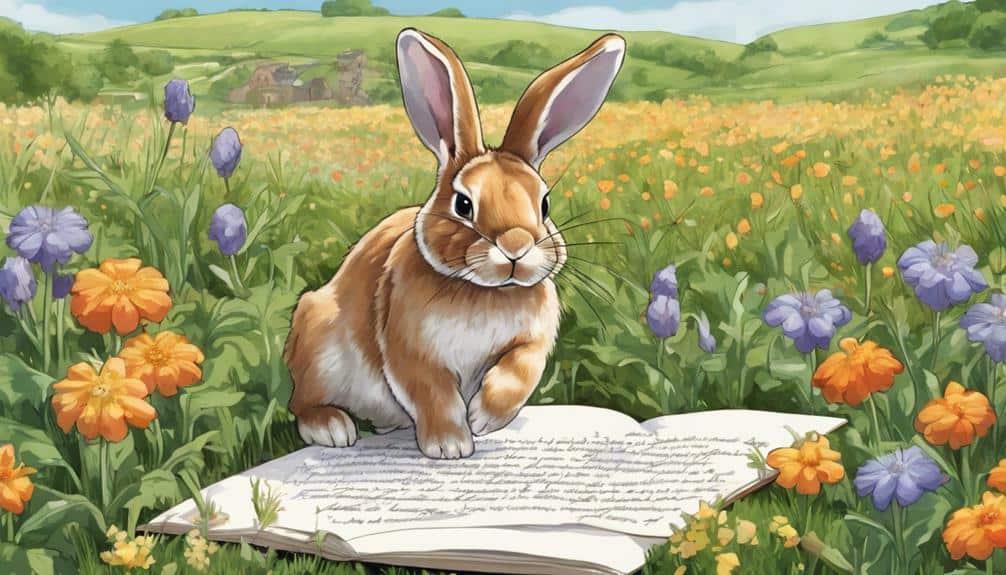
Through the centuries, writers have skillfully woven the evolving symbolism of bunnies into the intricate tapestry of literary expression. Bunnies have changed from their origins in ancient cultures, where they symbolized fertility and rebirth, to becoming representations of innocence and playfulness in modern literature. The evolution of bunny symbolism in writing mirrors the shifts in cultural beliefs and societal values over time, offering readers a deeper understanding of the narratives they encounter.
- Writers have utilized bunnies to convey themes of fertility, rebirth, and innocence in their works, drawing on the creatures' symbolic meanings from ancient times.
- Bunny symbolism in writing serves as a reflection of cultural beliefs, showcasing how these animals have been used to represent various aspects of human life and experiences.
- From being allegorical figures in Aesop's fables to playing central roles in contemporary fiction, bunnies continue to be versatile symbols that explore a wide range of emotions and themes in literature.
Bunny Symbolism in Classic Works
In classic literary works, the symbolic portrayal of rabbits explores themes of curiosity, adventure, intelligence, sensitivity, and leadership, enriching the narratives with layers of meaning and depth. Rabbits and hares have been significant symbols in many different cultures, representing qualities ranging from playfulness to wisdom.
In Lewis Carroll's 'Alice's Adventures in Wonderland,' the White Rabbit embodies curiosity, leading Alice into a fantastical world of whimsy and discovery. 'Watership Down' by Richard Adams explores the symbolism of rabbits, portraying them as creatures of sensitivity, cleverness, and exploration in a complex society.
Popular culture icons like Bugs Bunny showcase playfulness, resourcefulness, and a hint of mischief, engaging audiences with his antics. Peter Rabbit, a creation of Beatrix Potter, symbolizes bravery, mischievousness, and the importance of strong bonds in storytelling.
Throughout classic works, the rabbit remains a symbol of good luck, fertility, and leadership, adding depth and richness to the narratives they inhabit.
Modern Interpretations of Bunny Symbolism
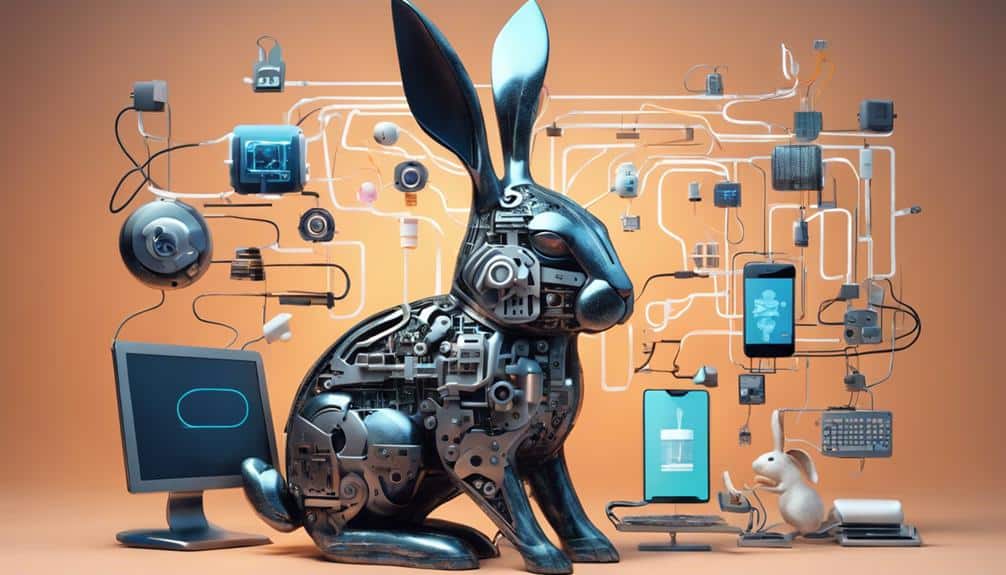
Exploring contemporary perspectives on bunny symbolism reveals a nuanced blend of eco-friendliness, kindness, and intelligence intertwined with modern cultural values. Bunnies are no longer just cute creatures but have become powerful symbols in today's society, representing various meanings and values:
- Eco-Friendliness: In modern interpretations, bunnies are often associated with eco-friendliness, symbolizing the importance of sustainability and environmental conservation in a world facing increasing ecological challenges.
- Kindness and Intelligence: Bunnies are seen as gentle creatures that embody kindness and intelligence, reflecting the modern emphasis on empathy, compassion, and mental acuity in interpersonal relationships and societal contexts.
- Cultural Importance: The bunny's association with the moon, such as the 'rabbit in the moon' motif present in different cultures, highlights its enduring cultural importance as a symbol of mystery, femininity, and creativity across various societies.
These interpretations showcase how bunnies have evolved beyond mere fluffy companions to represent deeper values and beliefs in contemporary cultural expressions.
Frequently Asked Questions
What Is the Symbolic Meaning of a Rabbit?
In various cultures, a rabbit symbolizes fertility, abundance, rebirth, innocence, agility, intuition, and playfulness. These symbols depict positive qualities and characteristics, emphasizing the importance of these traits in one's life and interactions with others.
What Do Rabbits Symbolize in Native American Culture?
In Native American culture, rabbits symbolize Indigenous connections, spiritual associations, and tribal beliefs. Folklore interpretations depict them as mythical figures teaching traditional meanings through their cleverness. These cultural symbols carry deep significance in tribal beliefs.
What Is Significant About Rabbits?
When you look at rabbits, you see more than cute pets. They are fertility symbols, luck charms, and tied to Easter traditions. In folklore, they represent rapid reproduction and are linked to the moon, embodying magic and mystery.
What Do Rabbits Symbolise in Literature?
In literature, rabbits symbolize various traits like curiosity, intelligence, and resourcefulness. They often represent deeper themes and societal values. Characters such as Bugs Bunny and Peter Rabbit embody these qualities, reflecting human behavior and values.
Conclusion
As you explore the rich tapestry of bunny symbolism across literature and cultural traditions, you uncover a world teeming with curiosity, fertility, and playfulness.
Like a rabbit darting through a sunlit meadow, these symbolic meanings leap off the page and into your imagination, leaving a trail of wonder and enlightenment in their wake.
The evolution of bunny symbolism in writing reflects humanity's enduring fascination with these creatures, forever woven into the fabric of our collective consciousness.

